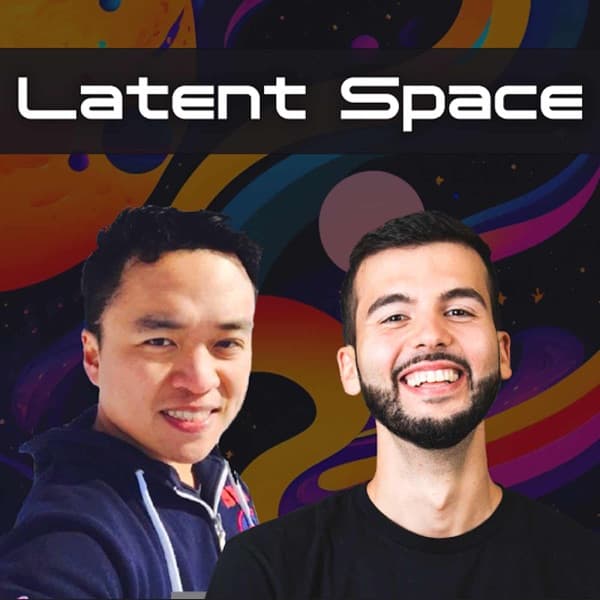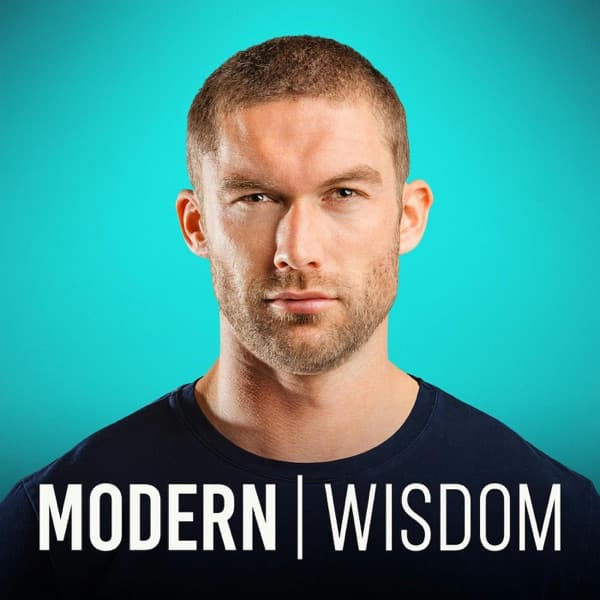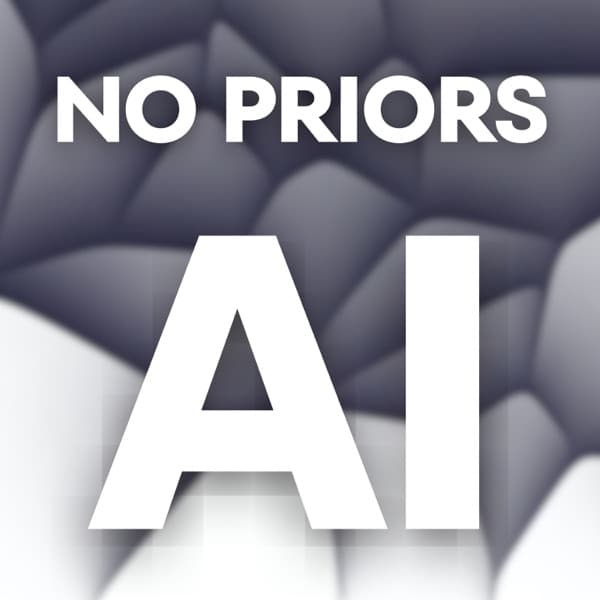All-In with Chamath, Jason, Sacks & Friedberg: The podcast discusses predictions for 2025, focusing on political, business, and media trends.
Latent Space: The AI Engineer Podcast: The podcast discusses the evolution of image diffusion tools, highlighting the transition from Automatic1111 to Comfy UI, and the impact of open-source development on the ecosystem.
Modern Wisdom: Differences in natural ability often stem from differences in opportunity and motivation.
All-In with Chamath, Jason, Sacks & Friedberg - 2025 Predictions with bestie Gavin Baker

The hosts and guest Gavin Baker discuss various predictions for 2025, including political winners and losers, business trends, and media developments. Politically, they predict fiscal conservatives and younger candidates will gain prominence, while progressivism and figures like Putin may face setbacks. In business, they foresee the rise of autonomous hardware and stablecoins, with potential challenges for traditional enterprise software and government service providers. Media predictions include the impact of AI on video games and potential declassification of government files by the Trump administration. The conversation also touches on the potential for UFO disclosures and the implications of AI advancements.
Key Points:
- Fiscal conservatives and younger political candidates are expected to gain influence in 2025.
- Autonomous hardware and stablecoins are predicted to be major business trends.
- Traditional enterprise software may face challenges due to AI advancements.
- Media developments include AI-driven video games and potential government file declassifications.
- The podcast also speculates on UFO disclosures and AI's impact on society.
Details:
1. 🎙️ Welcome to the All In Podcast
- The introduction segment does not contain specific actionable insights or concrete metrics.
2. 🏆 Bestie Awards and Special Guest Introduction
2.1. 🏆 Bestie Awards and Strategic Promotions
2.2. Special Guest Introduction
3. 💼 Atreides Management and Investment Strategies
- Atreides Management is a crossover investment firm specializing in both public and private investments in the consumer and tech sectors.
- The firm invests across a wide range from Series A to mega-cap companies, indicating a flexible investment strategy capable of engaging with companies at various growth stages.
- Atreides has invested in notable companies such as [Example Company A] and [Example Company B], showcasing their involvement in significant market players.
- Their strategy includes identifying high-growth potential opportunities and leveraging their experience in both public and private markets to maximize returns.
- They utilize a comprehensive due diligence process to assess potential investments, ensuring alignment with their strategic goals and risk management criteria.
4. 🔮 Super Predictions and Polymarket Collaboration
- Gavin's firm is valued at roughly $4 billion, indicating a significant market presence and influence in the prediction industry.
- Participants are tasked with making 'super predictions', each responsible for one or two major predictions, emphasizing strategic foresight.
- These predictions are integrated with Polymarket, a platform where users can place wagers on various outcomes, blending predictive insights with market speculation to potentially drive better decision-making.
- The collaboration not only leverages the $4 billion firm’s expertise but also enriches Polymarket’s offering by adding a layer of professional analytics to its betting markets.
5. ⛷️ Ski Trip Adventures and Progress
- A strategic partnership was formed with Polymarket, facilitating the creation of custom markets on their platform, enhancing engagement and tracking prediction accuracy.
- These markets enable global participation, offering public trading of predictions, except for those based in the US due to regulatory constraints.
- The initiative includes an 'All-In' section on Polymarket, allowing users to view, engage, and participate in these markets, fostering community involvement.
- This collaboration aims to leverage the predictive insights from these markets to improve decision-making processes and market understanding.
- Potential challenges include navigating regulatory landscapes and ensuring market integrity, which are actively addressed in the partnership strategy.
6. 🗳️ Political Predictions: Winners and Losers of 2025
- The 2025 political landscape is predicted to see significant changes, with emerging leaders and potential shifts in party dominance.
- Key political figures and parties are preparing strategic campaigns to address current economic and social issues, aiming for broader voter appeal.
- Innovative policies related to climate change, healthcare, and technology are likely to influence voter decisions and shape the election outcomes.
- Demographic shifts, including young voters and minority groups, are expected to play a crucial role in determining the winners and losers.
- Political analysts are focusing on battleground states and swing regions that could tip the balance in tightly contested races.
7. 📉 Political Losers and Economic Shifts
- The conversation highlights political predictions for the 2025 elections, focusing on the potential rise of independent parties and centrists.
- Friedberg predicts a significant increase in the influence of independent third-party candidates in the US political landscape, using Robert Kennedy's emergence as a notable example.
- Chamath argues that independent centrists will be crucial in shaping electoral outcomes, drawing on their pivotal roles in Biden's 2020 and Trump's 2024 elections.
- There is a debate on the impact of independent centrists, with some consensus that a notable number of lifelong Democratic voters supported Trump, highlighting a shift in voter behavior.
8. 💡 Business Trends and Technological Innovations for 2025
- Fiscal conservatives are predicted to emerge as significant political winners in 2025 due to a shift towards austerity measures.
- Austerity is expected to reveal the extent of waste, fraud, and abuse in the US federal government, potentially influencing state elections.
- A trend towards younger political candidates is anticipated, with a shift away from the aging political class as new names and resonant messages emerge by the 2025 midterms.
- The political climate suggests a growing demand for transparency and accountability, which could lead to regulatory changes affecting business operations, particularly in sectors dependent on federal contracts.
- Businesses should prepare for potential shifts in fiscal policy that may impact corporate taxes and government spending, affecting overall market conditions.
9. 📉 Challenges for Traditional Business Models
- There is a significant shift in political influence towards Gen X and elder millennials, with prominent figures like Elon Musk and Marco Rubio representing this demographic.
- This shift suggests a potential change in priorities, moving beyond self-interest and potentially impacting traditional business models.
- Traditional businesses may face challenges adapting to the values and expectations of this demographic, which may differ from previous generations.
- To remain competitive, businesses might need to reevaluate their strategies to align with the emerging priorities of Gen X and elder millennials, which could include a greater focus on sustainability, technology integration, and social responsibility.
10. 🤔 Contrarian Beliefs and Societal Impacts
- Xi Jinping faces challenges as Europe rearms, causing shifts in global military focus, impacting China's strategic goals regarding Taiwan. This rearmament is a response to perceived threats and changes in international defense strategies.
- Predictions suggest Putin will be the biggest political loser by 2025 due to geopolitical realignments and internal losses, particularly in the context of Russia's diminishing influence and economic challenges.
- The U.S. may reallocate military resources from Europe to the Pacific, complicating China's plans in the region. This shift underscores a strategic pivot towards addressing the growing influence of China.
- A potential decoupling between China and Russia is anticipated as a strategic response to changing alliances, which could alter the balance of power in international relations.
- The emphasis on Europe rearming highlights a shift in international defense strategies, affecting global power dynamics. This rearmament is driven by an increased focus on self-reliance and regional security concerns.
11. 📊 Prediction Markets and Conclusion
- Freeburg predicts that pro-war neocons will be the biggest political losers in 2025, indicating a potential shift in political power dynamics.
- The prediction suggests a confrontation with influential figures like J.D. Vance and Elon Musk, highlighting changing political alliances and influence.
- Freeburg's strong commitment to this prediction demonstrates confidence in the anticipated political shift and its significance in shaping future policies.
Latent Space: The AI Engineer Podcast - AI Engineering for Art — with comfyanonymous, of ComfyUI

The podcast episode explores the journey of Comfy UI, an open-source tool for image diffusion, which has gained popularity due to its powerful and flexible node-based workflow. Initially, Automatic1111 was the leading tool in the stable diffusion community, but Comfy UI has emerged as a preferred choice due to its ability to handle complex workflows and integrate various models. The episode features an interview with Comfy Anonymous, the creator of Comfy UI, who shares insights into the development process and the challenges faced in optimizing the tool for local use. The discussion also covers the impact of open-source development, with multiple startups building on Comfy UI's framework, and the potential for diffusion tools to expand into non-image domains by 2025. Additionally, the episode touches on the technical aspects of Comfy UI, such as memory management and the use of custom nodes, which allow for extensive customization and integration with other applications like Krita.
Key Points:
- Comfy UI offers a powerful node-based workflow for image diffusion, allowing users to chain models and orchestrate complex operations.
- The tool has gained popularity due to its open-source nature, enabling startups to build on its framework and offer services.
- Comfy UI's development focused on optimizing local performance, with features like smart memory management and asynchronous execution.
- The transition from Automatic1111 to Comfy UI reflects a shift towards more sophisticated workflows in the image diffusion space.
- Comfy UI supports various models and custom nodes, facilitating integration with applications like Krita and enabling creative uses like video game development.
Details:
1. 🎉 Reflecting on Achievements & Gratitude
- The podcast's dedicated support from listeners resulted in a significant 30-place climb in the podcast charts, highlighting the growing popularity and influence of the show.
- This improved ranking has enabled the podcast to secure high-profile guests, enhancing content quality and attracting a wider audience.
- The elevated position in the charts has also facilitated the organization of more industry events, further establishing the podcast as a key player in the industry.
- Listeners' engagement and feedback have been instrumental in shaping the podcast's direction and success, demonstrating the value of community involvement.
2. 🚀 Pioneering Interviews with Industry Leaders
- Successfully interviewed Drew Houston, CEO of the first public company featured on the platform, demonstrating a strategic move to include high-profile business leaders.
- Featured Josephine Tao, the first technology cabinet member, expanding the scope to include influential policy makers in technology.
- Achieved comprehensive coverage by interviewing leaders from top labs such as Meta, OpenAI, Anthropic, Rekha, Liquid, and Google DeepMind, providing insights into cutting-edge technological advancements.
- Introduced an anonymous guest in the 101st episode, setting a new precedent for content diversity and inclusivity in interviews.
3. 🌌 The Genesis of Latent Space Post-Stable Diffusion
- Latent space emerged right after the stable diffusion phase, marking a pivotal moment in technological evolution, characterized by enhanced capabilities in data processing and model training.
- This transition enabled uncredentialed software engineers to contribute significantly, democratizing access to advanced AI technology and paving the way for the development of large language models (LLMs).
- The emergence of latent space allowed for more efficient and sophisticated model training methods, reducing training times and improving accuracy.
- By lowering the barriers to entry, the latent space phase encouraged innovation and experimentation, leading to rapid advancements in AI applications.
4. 💻 Transition from SDWebUI to Comfy UI in Image Tools
- The app created by Automatic1111 quickly gained over 100,000 GitHub stars due to its rapid plugin development and user-friendly interfaces for the stable diffusion ecosystem.
- Comfy UI, developed by Comfy Anonymous, is now the preferred tool in the image diffusion space, replacing Automatic1111.
- The transition signifies a shift in focus from simple prompting and tweaking settings in 2022 to implementing more complex and parallel workflows.
- Comfy UI allows for chaining together different models and orchestrating long-running operations, including video processing.
- Users benefit from an intuitive canvas that visualizes these complex workflows.
- Comfy UI supports more sophisticated features than SDWebUI, such as parallel processing and model chaining.
- Transitioning might pose challenges, such as the learning curve associated with new workflows and features.
- User feedback indicates a preference for Comfy UI’s intuitive design and enhanced capabilities.
5. 🔍 Open Source Empowerment & Startups
- Comfy UI, an open-source platform, has catalyzed the formation of multiple Y Combinator startups that either extend its workflow or offer it as a service, showcasing the potential for open-source projects to foster innovation in the startup ecosystem.
- The success of Comfy UI's workflow tooling is notable in its domain, unlike other modalities where similar tooling hasn't gained significant traction, indicating a unique alignment between the platform's features and market needs.
6. 🗓️ Upcoming AI Engineer Summit Announcement
6.1. Summit Details
6.2. Track Highlights
7. 🎙️ Welcoming Comfy Anonymous to the Podcast
- The Latent Space Podcast hosts Alessio and Swix introduce their first anonymous guest, Comfy Anonymous, marking a unique moment for the podcast.
- Alessio is a partner and CTO at Decibel Partners, while Swix is the founder of SmallAI, establishing their expertise and industry background.
- The recording takes place in the Chroma Studio, suggesting a professional setup for the podcast.
- Comfy Anonymous is referred to simply as 'Comfy', highlighting a casual and approachable persona.
8. 🤖 Comfy UI's Development & Swix's Journey
8.1. Development of Comfy
8.2. Swix's Initial Steps and Contributions
9. 🔄 Innovations in Image Generation & Workflow
- The exploration of stable diffusion models began in October 2022, leading to significant advancements in image generation techniques.
- Initial image outputs were low-resolution; the high-res fix technique was developed, involving low-res generation followed by upscaling and refinement.
- This process included experimenting with different samplers and settings, which were crucial to improving image quality.
- Python was extensively used for automating tasks, showcasing the integration of software engineering skills into the image generation process, despite no prior experience with diffusion models.
- A node graph interface was identified as an effective method for visualizing the diffusion process, aiding user interaction.
- The pursuit of high-resolution images led to extensive experimentation with samplers and steps, surpassing the basic high-res fix initially available.
10. 🛠️ Advanced Tools for Image Customization
- The initial auto code base was not suitable, prompting the creation of a custom interface.
- Development was initiated independently without a team, starting on January 1, 2023.
- The first version was released on GitHub by January 16, 2023, demonstrating a rapid development cycle of just 15 days.
- The interface was named 'Comfy UI' due to the 'comfy' nature of the images it produced, reflecting its user-friendly design and functionality.
- Challenges included working without a team and ensuring the interface met user needs effectively.
- Post-release, the interface gained positive reception for its intuitive design and effectiveness in image customization.
11. 🧩 Comfy UI's Features & Community Ecosystem
11.1. Features of Comfy UI
11.2. Community Engagement and Impact
12. 🧠 Insights on Stable Diffusion Models
- Area composition involves a detailed diffusion process where different prompts are applied and averaged to produce refined images. This technique allows for nuanced control over image generation.
- The concept of multi-diffusion, introduced shortly after area composition, shares similarities but is documented as a distinct process in academic literature.
- Both area composition and multi-diffusion can be implemented across various models as long as they operate within the same latent space, enhancing their versatility.
- Models operating in pixel space are generally slower, presenting a limitation when compared to stable diffusion models, which are optimized for speed and efficiency.
13. 🖥️ Overcoming Technical Challenges in UI Development
13.1. Latent Diffusion Models in UI Development
13.2. Stability AI's Approach to Model Improvement
14. 🔧 Memory Management and GPU Optimization
- The 'refiner' as a diffusion model is underutilized despite its image generation capabilities.
- Stable diffusion remains the most recognized model, while Flux has gained significant traction.
- SD 3.5 consists of two models: a smaller 2.5B and a larger 8B, offering more creativity but smaller size compared to Flux.
- Flux is considered the best for consistency, whereas SD 3.5 is recommended for creative use cases.
- Support for closed-source model APIs is available through custom nodes, including official ones from Ideogram and DALI.
- The 'refiner' model can be optimized for better GPU usage and efficiency in memory management.
- Stable diffusion models, specifically SD 3.5, show a reduction in memory usage by 20% compared to earlier versions.
- Flux's model architecture allows for seamless scaling, improving processing speed by 30%.
15. 🌍 Understanding Market Trends & Compatibility
- Transition from SD 1.5 to SD 2 and SD 3 shows mixed adoption, with SD 1.5 retaining a strong user base due to its stability and user satisfaction.
- SD 2 was largely ignored because it didn’t offer substantial improvements over SD 1.5, leading users to skip this version.
- SD 3 captured attention upon release, but its adoption was hampered by the overshadowing of Stable Cascade, a model that was ready months prior but delayed due to internal processes.
- Stable Cascade, despite being a good model, lost momentum due to its late release and timing issues, highlighting the importance of strategic release timing.
- Naming conventions and perceived improvements are crucial in influencing product adoption, as seen in the mixed responses to these models.
16. 🧑💻 Custom Nodes & Ecosystem Expansion
- The AI research community is highly dynamic, often quickly adopting new models and technologies, which can lead to not fully exploring the capabilities of existing models.
- Significant improvements in model performance are the primary driver for the community's shift to new models, rather than incremental updates.
- Models with a similar parameter count tend not to show massive performance improvements, which affects adoption rates.
- Rapid adoption of new models can disrupt the ecosystem by potentially sidelining comprehensive exploration of existing technologies.
17. 🌀 Exploring Video Models and Future Directions
- Model-specific workflows can create challenges when transitioning between models due to the need for comprehensive changes in prompts and workflow configurations.
- Evaluating improvements in video and image models often relies on subjective aesthetic judgments rather than scientific metrics, which can complicate the assessment process.
- The 'comfy workflows' community evaluates model outputs based on personal preferences, contrasting with more structured evaluation approaches in scientific settings.
- Training models on large datasets of internet images can result in outputs that are technically consistent but lack aesthetic appeal, highlighting the gap between technical performance and artistic quality.
18. 🔍 Delving into LORAs and Textual Inversions
18.1. Overview of Textual Inversions
18.2. Overview of LORAs
19. 📊 Evaluations and Artistic Considerations in Image Generation
- Clip models have been fine-tuned to accept longer prompts, increasing from 77 tokens to 256 tokens in Long Clip.
- Long prompts can be processed by splitting them into chunks, though this method is not ideal.
- Prompt weighting and negative prompting are effective with SD 1.5 due to ClipL's high input-output token correlation.
- Deeper text encoders reduce the effectiveness of prompt weighting; it is less effective on models like T5XSL.
- LoRa enables model customization by fine-tuning smaller weights, thus requiring fewer resources than full model fine-tuning.
20. 💬 Comfy UI's Role and Future in the Ecosystem
- Training smaller matrices is less painful and more portable, allowing for easier sharing and collaboration across different platforms and projects.
- LORAs (Low-Rank Adaptations) enable efficient inferencing by applying directly on weights with minimal delay, ensuring high-speed performance critical for real-time applications.
- While not true compression, different algorithms for representing weight differences act as transformations, optimizing resource use and enhancing model adaptability.
- Comfy UI intentionally diverges from the simplicity trend by offering a powerful, albeit complex, interface that caters to advanced users seeking greater control and functionality.
- Key features include a robust node execution engine and the capability to re-execute workflows from any modified point, improving efficiency and flexibility in development processes.
Modern Wisdom - #885 - Adam Grant - How To Overcome Your Fear Of Failure & Unlock Your Potential

The discussion emphasizes that what appears as natural talent is often a result of early opportunities and motivation. Benjamin Bloom's study on world-class performers revealed that their success was not due to innate brilliance but rather their passion and the opportunities they had to practice. Motivation often comes from early teachers or coaches who make learning enjoyable, which can lead to self-reinforcing motivation as skills improve. The conversation also highlights the importance of recognizing and nurturing hidden potential, which can be overlooked by both individuals and those around them. Practical applications include creating environments that foster motivation and opportunities for growth, and understanding that potential is not fixed but can be developed through skill improvement and motivation shifts.
Key Points:
- Natural talent is often a result of early opportunities and motivation, not innate ability.
- Motivation can be sparked by engaging teachers or coaches who make learning enjoyable.
- Hidden potential exists in everyone and can be developed with the right opportunities.
- Failure is a learning opportunity; expecting some failure can encourage risk-taking and growth.
- Critical ignoring and discerning information are vital skills in an age of information overload.
Details:
1. 🎨 Talent: More Opportunity than Innate Ability
- Success is more influenced by opportunity and motivation than by innate ability, as evidenced by historical examples where prodigies are rare and most successful individuals develop skills over time.
- Benjamin Bloom's study highlights that world-class performers were not innately brilliant but benefited from early opportunities to practice and a passion for learning.
- The recognition of talent often stems from enthusiasm and love for learning, rather than natural ability.
- Raw talent is frequently overestimated, while the significance of creating opportunities and fostering enthusiasm is underestimated.
2. 🚀 Motivation: Fun as a Catalyst for Excellence
- World-class performers often have early mentors who make learning enjoyable, which is crucial for maintaining motivation.
- Traditional learning activities like music scales or sports drills can be tedious, but making them enjoyable can enhance engagement and learning.
- Motivation tends to increase as individuals develop skills and achieve mastery, reinforcing the desire to continue learning.
- Viewing tasks as merely items to complete can lead to drudgery and reduced motivation.
- Motivation is influenced by external opportunities and environments, and can be cultivated by effective coaches and teachers who create engaging learning contexts.
3. 🧗♂️ Embracing Failure to Unlock Hidden Potential
3.1. Finding Unexpected Success through Persistence and Coaching
3.2. Understanding and Realizing Hidden Potential
3.3. Balancing Criticism and Compliments
3.4. Finding Meaning and Purpose in Work
3.5. Embracing Failure and Learning from Mistakes
3.6. Emotion Regulation and Managing Fear of Failure
3.7. Motivation and Emotional Drivers
4. 🎯 Expectations: Striking a Balance for Satisfaction
4.1. Personal Motivation and Expectations
4.2. Innovation in Presentations
4.3. Balancing Expectations for Happiness and Success
5. 🧠 Navigating Information Overload and Attention
- Criticizing is easy, creating is hard; intelligence is shown by building ideas, not tearing others down.
- Misery fosters scarcity mindset, joy promotes abundance; attitudes become self-fulfilling prophecies.
- Cynicism about others' motives can elicit negative behavior; assuming kindness can lead to more collaborative interactions.
- Avoiding cognitive destruction is more important than expediting success; biased blind spot ('I'm not biased' bias) is prevalent.
- Higher intelligence increases risk of 'I'm not biased' bias, leading to overconfidence and ignorance of one's limitations.
- Effective synthesis is key; 'symphony' skill—connecting diverse information into coherent understanding—becoming more valuable.
- Critical ignoring: discernment to quickly dismiss irrelevant information is vital amidst information overload.
- Dot connectors, not dot collectors, are now more valuable; ability to spot patterns and synthesize information is crucial in problem-solving.
6. 🔎 Meaning in Work: Beyond Achievement
6.1. Meta-Analysis on Attention
6.2. Achieving Satisfaction
6.3. Grounded Success
7. 🤝 Feedback and Vulnerability: Keys to Growth
- A study revealed that while 80% of parents claim they value their children's happiness and kindness, 70% of children perceive that achievement is prioritized over these values.
- Parents often engage in conversations centered on accomplishments like grades or sports scores, implicitly communicating that success is paramount.
- To counteract this, introducing questions such as 'Who did you help this week?' or 'Who helped you?' encourages children to focus on kindness and reciprocal support.
- Shifting conversations to value kindness and community involvement, not only with children but also with adults, accurately reflects core priorities and promotes a culture of growth and empathy.
- Feedback mechanisms that incorporate vulnerability, such as sharing personal challenges and failures, can enhance personal development and strengthen relationships.
Included Channels
 All-In with Chamath, Jason, Sacks & Friedberg
All-In with Chamath, Jason, Sacks & Friedberg Lex Fridman Podcast
Lex Fridman Podcast Modern Wisdom
Modern Wisdom In Depth
In Depth Greymatter
Greymatter Latent Space: The AI Engineer Podcast
Latent Space: The AI Engineer Podcast a16z Podcast
a16z Podcast Lenny's Podcast: Product | Growth | Career
Lenny's Podcast: Product | Growth | Career How I Built This with Guy Raz
How I Built This with Guy Raz Lightcone Podcast
Lightcone Podcast No Priors AI
No Priors AI The Twenty Minute VC (20VC): Venture Capital | Startup Funding | The Pitch
The Twenty Minute VC (20VC): Venture Capital | Startup Funding | The Pitch BG2Pod with Brad Gerstner and Bill Gurley
BG2Pod with Brad Gerstner and Bill Gurley






